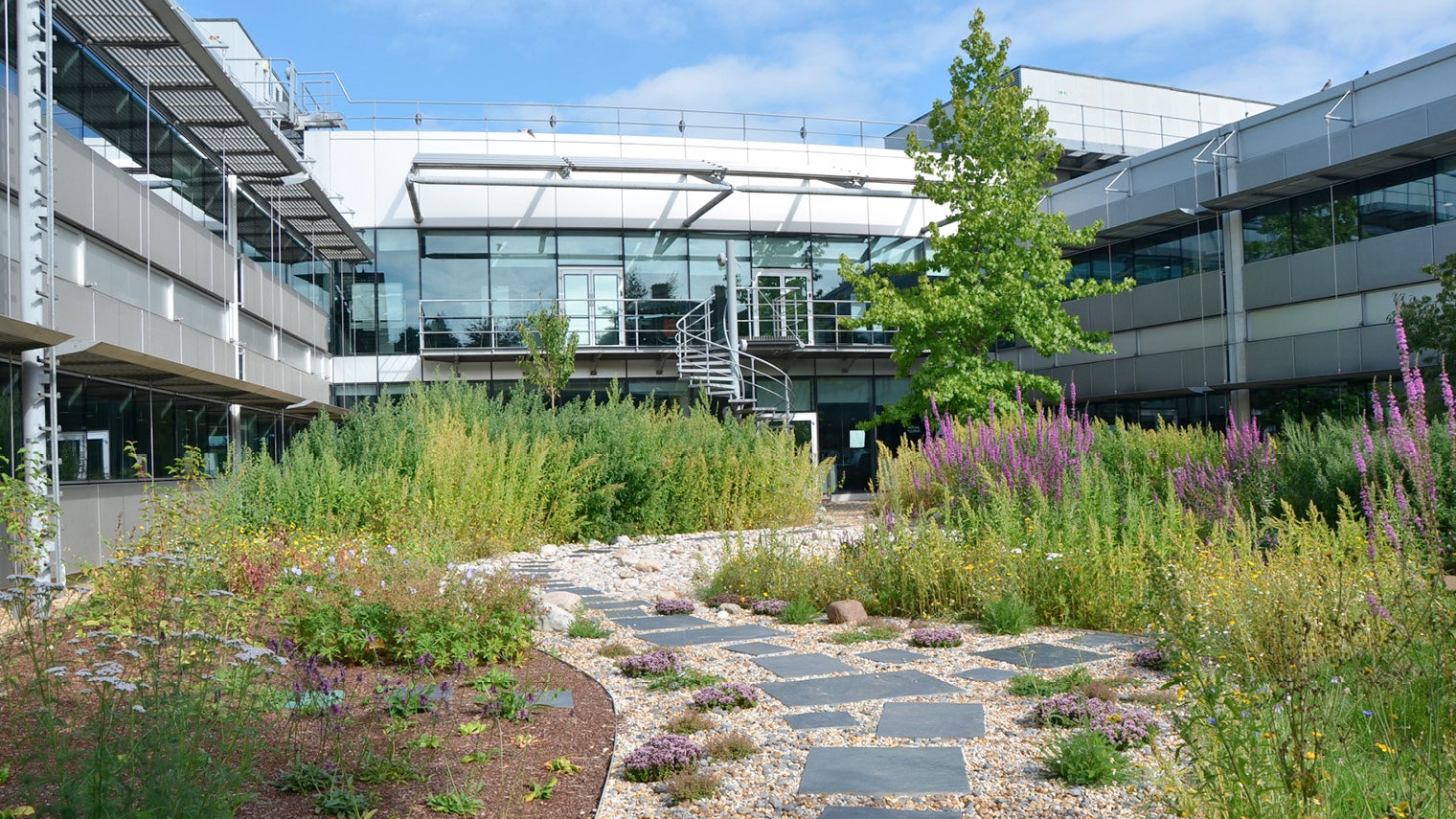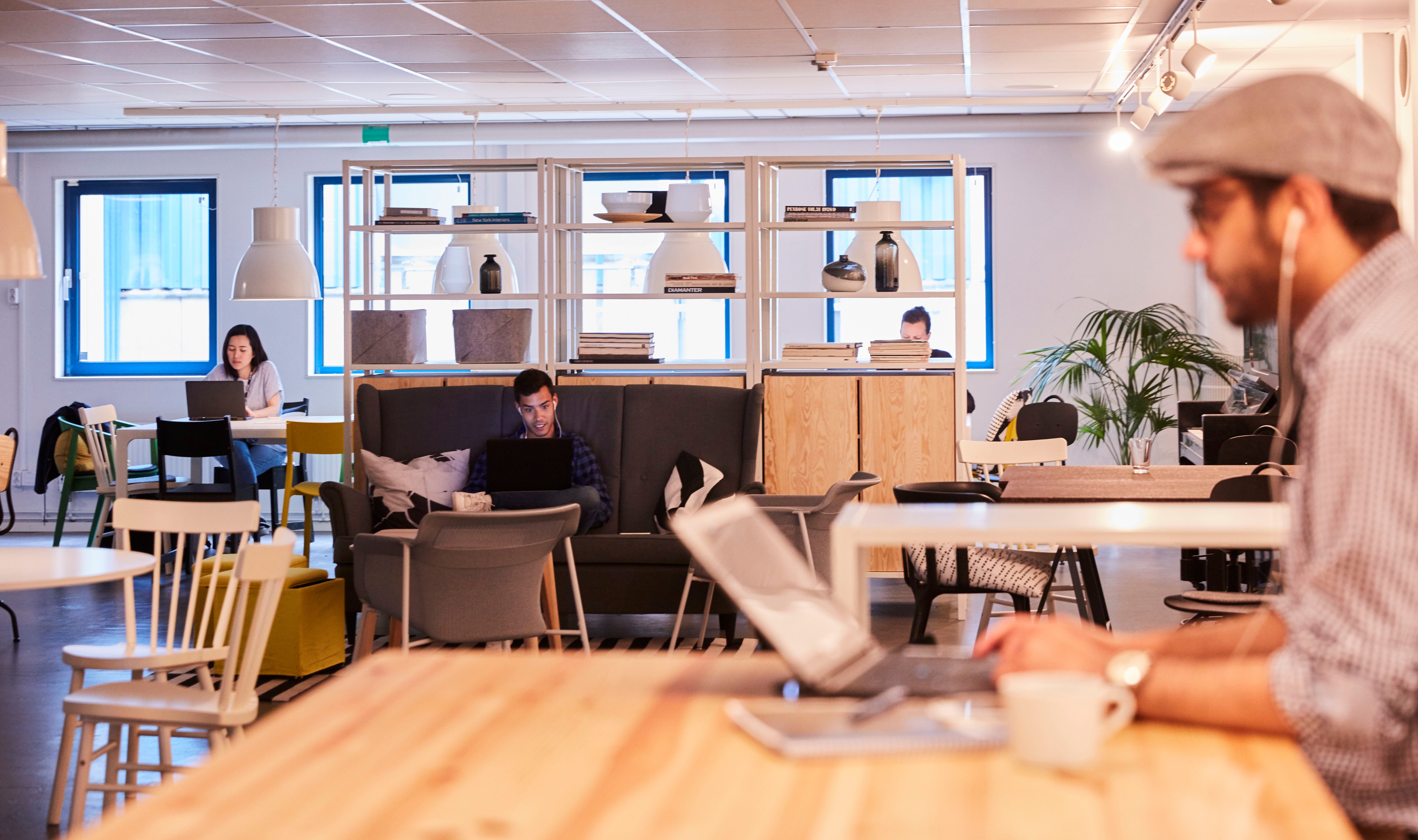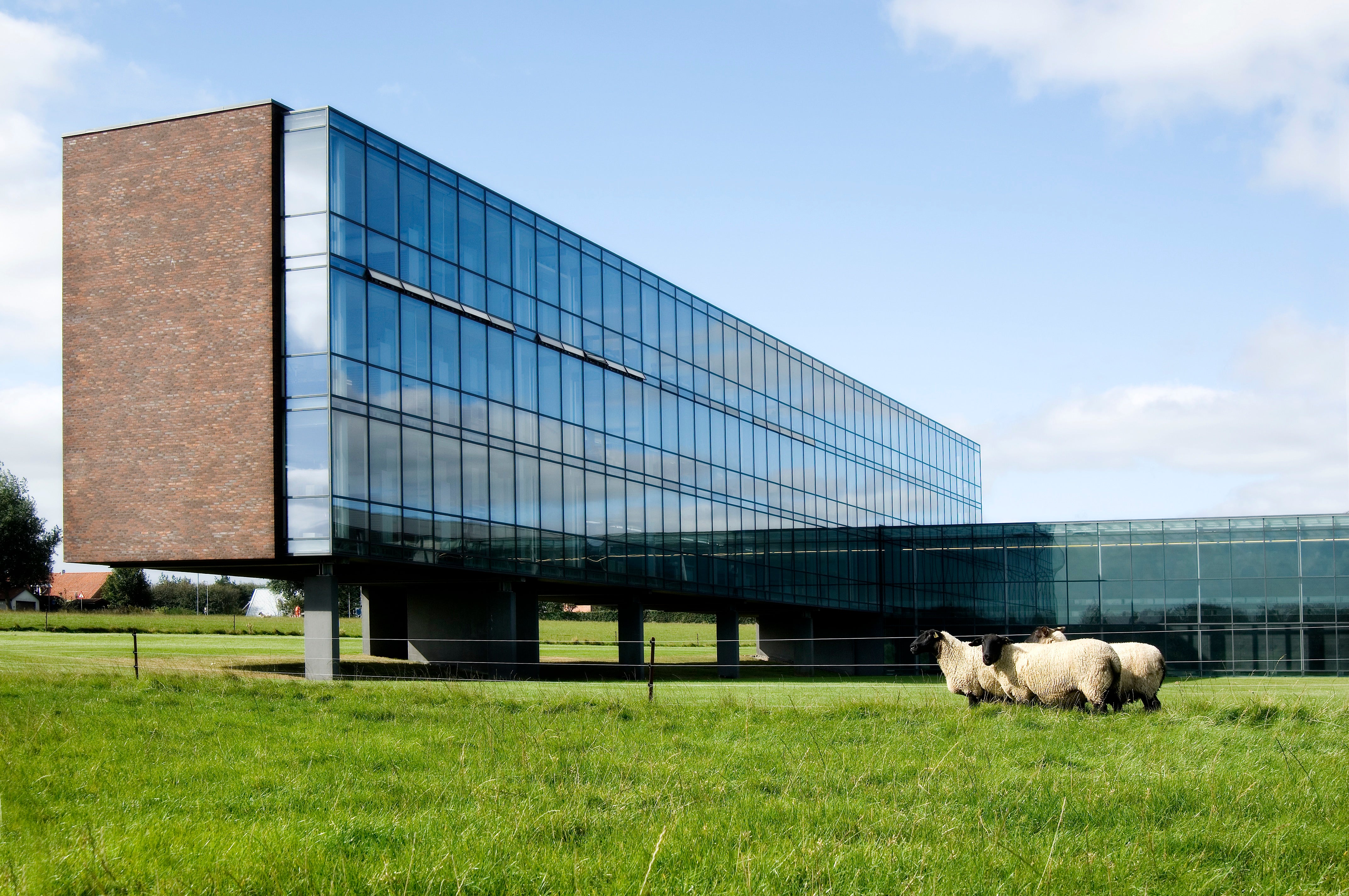Jody Ford, chief executive, PhotoBox Group
We recently moved into a new East London office called Herbal House, which holds 400 employees across our four online brands PhotoBox, Moonpig, Hofmann and PosterXXL. The building is an old print works, with four floors and a huge atrium in the middle, and each business is on a different floor. It has a post-industrial feel to it and light floods in.
One of the most important things has been creating flexible spaces where people can collaborate across teams. We now employ the “squad model” by putting together cross-department teams of five to ten people who work towards a specific goal.
We have a dedicated work space for squads with clear desks, whiteboards and screens where people can plug in their laptops. The set-up also means everyone on each squad is looking at each other.
We’ve been using this model for over a year now, and we’ve seen more engaged employees, an acceleration in Moonpig’s marketing efforts and customer conversion, and faster feature deployment.
Beyond this, we have many more flexible spaces, particularly in the basement, which has strings of unassigned desks where people can work or corners to have a quick catch-up with a manager.
There’s a long, core staircase that sweeps between three floors and means people run into each other throughout the day. This has encouraged people to chat and it’s made me much more visible as the chief executive, which I think is so important. There’s a screen that drops down and cushions available, so two thirds of the staircase turns into a space that holds 80 people for an all-hands meeting.
Creating more collaborative, agile spaces has empowered our employees to bring their best ideas forward and given them autonomy. The old command-and-control model doesn’t work anymore. This has unleashed the talent of employees who are closest to the coal face, helped drive accountability and has meant tasks get done quickly.

Rachel Shepherd, organisation development and human resources senior manager, Toyota
Toyota GB’s headquarters has been in Epsom, Surrey since 2001 and is a flexible environment centred on an area we call “the street”, which is a big, open-plan work space where we display our products. The layout is like a spider’s web, with the central area where people come together, then lots of wings with meeting areas.
Because the office is open plan, people sometimes need to take themselves away to a quiet or private space and do some thinking.
We’ve been doing a lot of research around innovation and something that’s come out of it is the value of giving people spaces to work that look different from their regular working environment.
We try to encourage people to utilise the whole building and outside spaces, and find alternative venues for meetings to help them think differently and creatively.
There are a series of open, garden spaces on the ground floor with seating. This is part of how we can create the right physical spaces for people to be innovative. They are also sustainable habitats for wildlife, which supports our global principle of working in harmony with the environment.
We’re soon going to be installing signage panels in the gardens to give people insight into the different areas. These will contribute to a walking route, which links to employee wellbeing and looks to get people physically active and engaging with the ecology. There are also picnic benches and shaded areas where people can work, have a meeting or relax.
To add to the number of alternative working spaces, we’re developing four innovation pods, three in the office and one outside. These will be used by individuals or groups as a source of stimulation; one will be modular, so it can be changed to suit different people’s needs or moved around the office. The idea is to take people into other environments to help them think differently.

Marili ‘t Hooft-Bolle, chief operating officer, WeTransfer
Work space design is very relevant for us as we’ve grown out of our current space and are moving into a former chewing gum factory in Amsterdam at the end of the year. The key thing will be flexibility, and striking the balance between majority open work space, meeting rooms of different sizes and spaces that turn into other things.
WeTransfer is a very creative company. A meeting room with stackable chairs will turn into a meditation space and our open-plan cafeteria can be transformed into a presentation hall or an exhibition space to showcase the work of new artists we are collaborating with.
Another important thing is light and air quality, which have an impact on employee energy and health. This factory building has a big, glass, shed-style roof, which is beautiful in terms of letting in light, but also means the sun is very bright. We’ve had to think about technicalities, such as how to gain as much light as possible, but not too much heat in summer.
As there’s a lot of light coming from the top, we’ve opened up the first floor so there’s a big atrium where the light will fall straight down into the ground level too. Then on both floors, we’ve drawn light lines on the ceilings that will allow desks to be placed horizontally or vertically in blocks of four, six or eight, basically any configuration.
We’ll install LED lights, which look most like natural light, and these overhead light lines will aim to cover all the working areas that could be configured in the space, to give a daylight feel. This allows areas with lower ceilings to have the feeling of natural sunlight.
We’ve also put a lot of time into climate and regulating heat to make the work space comfortable. We have a sophisticated mechanical system on the roof that takes air out of an area and blows it into another, which can regulate both air quality and temperature.

Jill Reedman, country interior design manager, IKEA UK and Ireland
One of the most vital things at IKEA is that everyone feels they are unique and important in how they contribute to the company. Part of this is ensuring they have the right, individual environments to work in.
Democratic design and accessibility is what we are all about, and something that is very reflective of this are our ‘fika’ spaces. It’s a Swedish word meaning to take a break, and get some energy. This could be through food, air, or socialising with others.
In our Wembley office, our fika area is at the crossroads of every flow within the office – every visitor will pass through it after they’ve been through reception. It has a coffee machine, microwave, dishwasher and sink, lots of seating elements and a screen that pulls down. There is furniture that adapts for purpose, such as long, folding trestle tables or round working tables.
It is a fluid space that can be anything to anyone, from communal lunches to a quick coffee to a football-watching amphitheatre. It’s currently being used to show World Cup games, supporting our international workforce who want to watch their home countries. It brings people together in chance encounters to cross-collaborate, something which used to be called the ‘water cooler moment’.
We also applied the same democratic design philosophy to co-worker restaurants. There are zones within them where employees can choose what they want to do – sit quietly, play games, or sit at different types of table depending on their needs such as a long communal one or a small one-to-one table.
Another important way of engaging co-workers is to have our own product ranges in the office around them to actively use. We have everything from ergonomic desks, to different foot rests for people’s posture or to raise their legs, to the right lighting, to textiles and plants.
This helps to instil identity and belonging in employees while also giving them practical and functional benefits. We talk about the IKEA ranges every day, so it’s important that they are integrated into everything we do. Maybe it’s subliminal, but the moment you feel comfortable, relaxed and are encouraged as an individual to contribute, this all means you are able to do your best.

Christian Iversen, senior vice president of HR and group functions, Bang & Olufsen
At Bang & Olufsen’s headquarters in Struer, Denmark, we decided a few years ago to move all our research and development (R&D) teams under one roof into a factory space, where we had been making products for years. Previously, all our teams had been scattered across three or four buildings.
This has given us a multi-disciplinary approach to how we innovate, make products and do business, which I feel is crucial and has sped up processes massively.
We moved everyone into the old factory floor in one big, open room. It’s an open-plan landscape, with flexible furniture, such as archives and tables on wheels, so people can be shifted around within the hour.
This means you can create a multi-disciplinary environment where we have engineers, acoustic specialists and testers sitting alongside the support team and even some marketing people.
Our core competency is around acoustics, and a quarter of our facility consists of listening or test rooms which are now sitting just next to project teams.
Previously, in the development of a product such as a loudspeaker, when it had to be tuned or optimised, it was taken out of the project and some people didn’t see it for days because it had to be taken to a special testing facility. Now, they can be taken straight to the right person.
We’ve gone from having a very secret, wall-to-wall R&D process where you complete one step and pass it on to someone else, to one that is very agile where everyone can work on a project at the same time. This speeds up development, and increases quality because you are able to capture issues during the process.
Having people in close vicinity has in turn changed the culture – it’s gone from emailing each other to engaging in dialogue. There is more transparency and visibility, and therefore much more holistic decision processes around our concepts.
There was a lot of scepticism and resistance towards moving towards an open-space and multi-disciplinary environment to start with, even though it needed to happen – many people have spent a lot of their career with us in the same office. So we ran the consultation beforehand as a bottom-up, open process, and conducted focus groups with all parts of the organisation.
It has certainly changed our way of working. Making physical changes to your environment is probably the best culture driver you can have.

Paul Dawson, vice president for health and beauty, Dyson
At Dyson’s headquarters in Malmesbury, a design feature we find really important is the need to be surrounded by engineering inspiration. We fill our workspaces with inventions and products which have had an impact on the world as this reminds us of the people who have challenged convention before us.
Being able to look at hands-on examples of pioneering work, many of which are from lesser-celebrated design icons, helps fuel the curiosity of our engineers and designers.
One of our icons is the Whittle Engine, (W.2B/23), the first British, production engine for aircrafts. It was built in 1943, then was sent to Canada during the war for cold weather testing. After the war it was sent to RAF Hullavington, four miles down the road from us. When it was decided that it was coming to Malmesbury, a group of our engineers volunteered to work together to restore it to its former glory.
This isn’t a new philosophy and we have been collecting inspirational products since before I joined the company, 18 years ago. Other favourites in the office have been the Rotring mechanical pencil, the JCB digger, and the Alex Moulton bicycle. Employees have also used contacts to bring in loan-pieces they think are interesting for the rest of the team to see.
These aren’t museum artefacts – they are accessible and there to be touched and understood, from the engineering to the idea to the frustrations and failures along the way, too. When finding solutions to engineering problems, you need spaces that support designing, building and testing of prototypes and encourage open discussions in the team. The objects create diverse and unique workspaces that bring the team together to talk.
Having spaces filled with objects often starts conversations or facilitates meetings, and a team that speaks to each other face-to-face works better than one which communicates purely over email.








